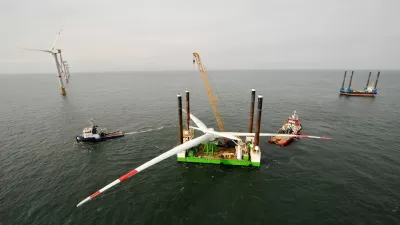Last week the foundations for five wind turbines were towed into place off Block Island, 13 miles east of Rhode Island in the Atlantic Ocean. Scheduled to go online in 2016, they will be the first offshore wind turbines in the United States.
While the 30 megawatt, five-turbine Block Island Wind Farm may pale in comparison to the 130 turbines planned for Cape Wind in Nantucket Sound, a project that has received far greater attention but remains stalled, the importance of this event can not be overstated. Construction began Monday, reports Maritime Executive.
"It’s a moment that its supporters have long anticipated, billing it as nothing less than the dawn of a new clean energy future for the United States, which lags Europe and China in harnessing ocean gusts for electricity," writes Diane Cardwell, Business Day reporter for The New York Times, on what will be "the nation’s first commercial-scale offshore wind farm."
Deepwater Wind, the company that is developing the farm, is pressing ahead. It holds a 30-year lease on a parcel in federal waters nearby — about 256 square miles about 15 miles southwest of Martha’s Vineyard — with room for as many as 250 turbines.
In addition to that site, known as Deepwater One, the company has plans for a site off the New Jersey coast, known as Garden State Offshore Energy, for 200 turbines generating one gigawatt of energy. That project should not be confused with the much smaller Fishermen’s Energy project off the Jersey coast that remains stalled.
For the United States to catch up to other countries like Denmark, which opened the world's first offshore wind farm in 1991, "stable subsidies and mandates — and coordination among the states," will be required, warned policy experts and business executives, or "offshore wind development will be limited to a few small demonstration projects," writes Cardwell.
FULL STORY: Offshore Wind Farm Raises Hopes of U.S. Clean Energy Backers

Maui's Vacation Rental Debate Turns Ugly
Verbal attacks, misinformation campaigns and fistfights plague a high-stakes debate to convert thousands of vacation rentals into long-term housing.

Planetizen Federal Action Tracker
A weekly monitor of how Trump’s orders and actions are impacting planners and planning in America.

San Francisco Suspends Traffic Calming Amidst Record Deaths
Citing “a challenging fiscal landscape,” the city will cease the program on the heels of 42 traffic deaths, including 24 pedestrians.

Defunct Pittsburgh Power Plant to Become Residential Tower
A decommissioned steam heat plant will be redeveloped into almost 100 affordable housing units.

Trump Prompts Restructuring of Transportation Research Board in “Unprecedented Overreach”
The TRB has eliminated more than half of its committees including those focused on climate, equity, and cities.

Amtrak Rolls Out New Orleans to Alabama “Mardi Gras” Train
The new service will operate morning and evening departures between Mobile and New Orleans.
Urban Design for Planners 1: Software Tools
This six-course series explores essential urban design concepts using open source software and equips planners with the tools they need to participate fully in the urban design process.
Planning for Universal Design
Learn the tools for implementing Universal Design in planning regulations.
Heyer Gruel & Associates PA
JM Goldson LLC
Custer County Colorado
City of Camden Redevelopment Agency
City of Astoria
Transportation Research & Education Center (TREC) at Portland State University
Jefferson Parish Government
Camden Redevelopment Agency
City of Claremont



























